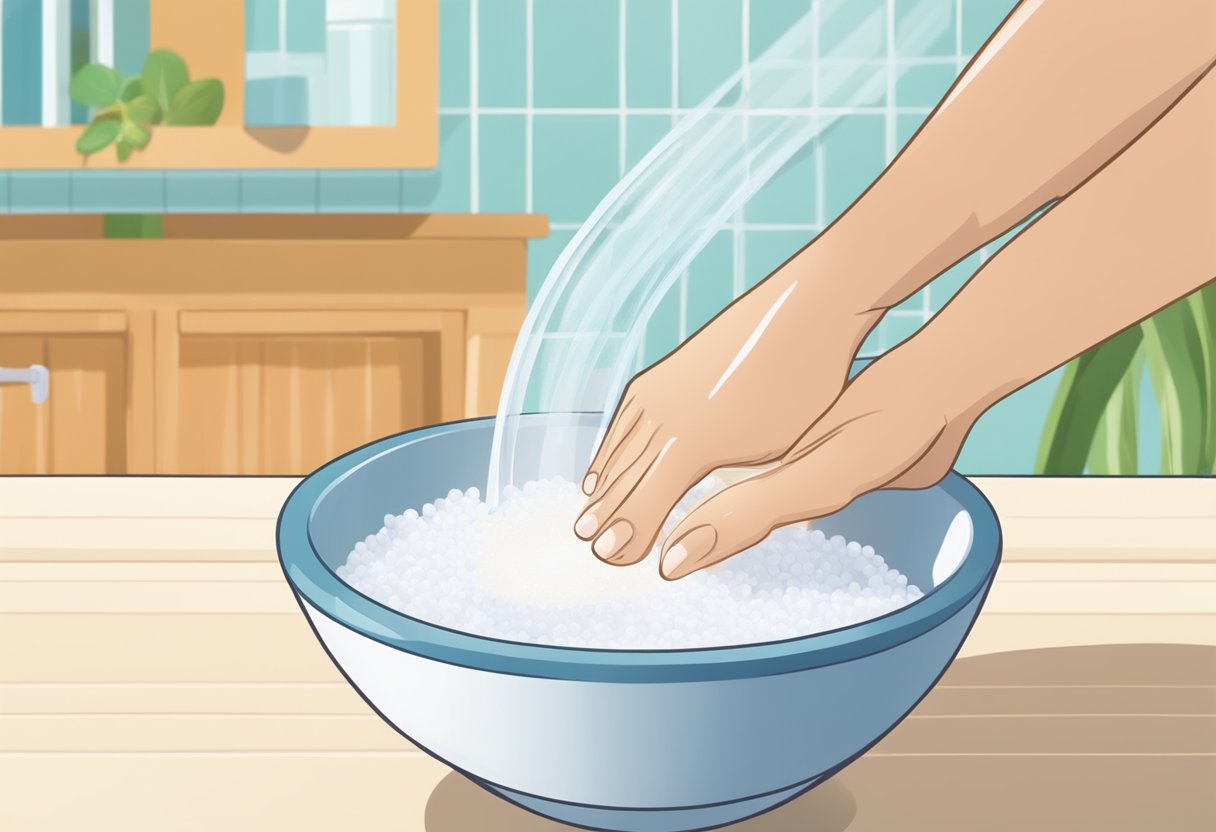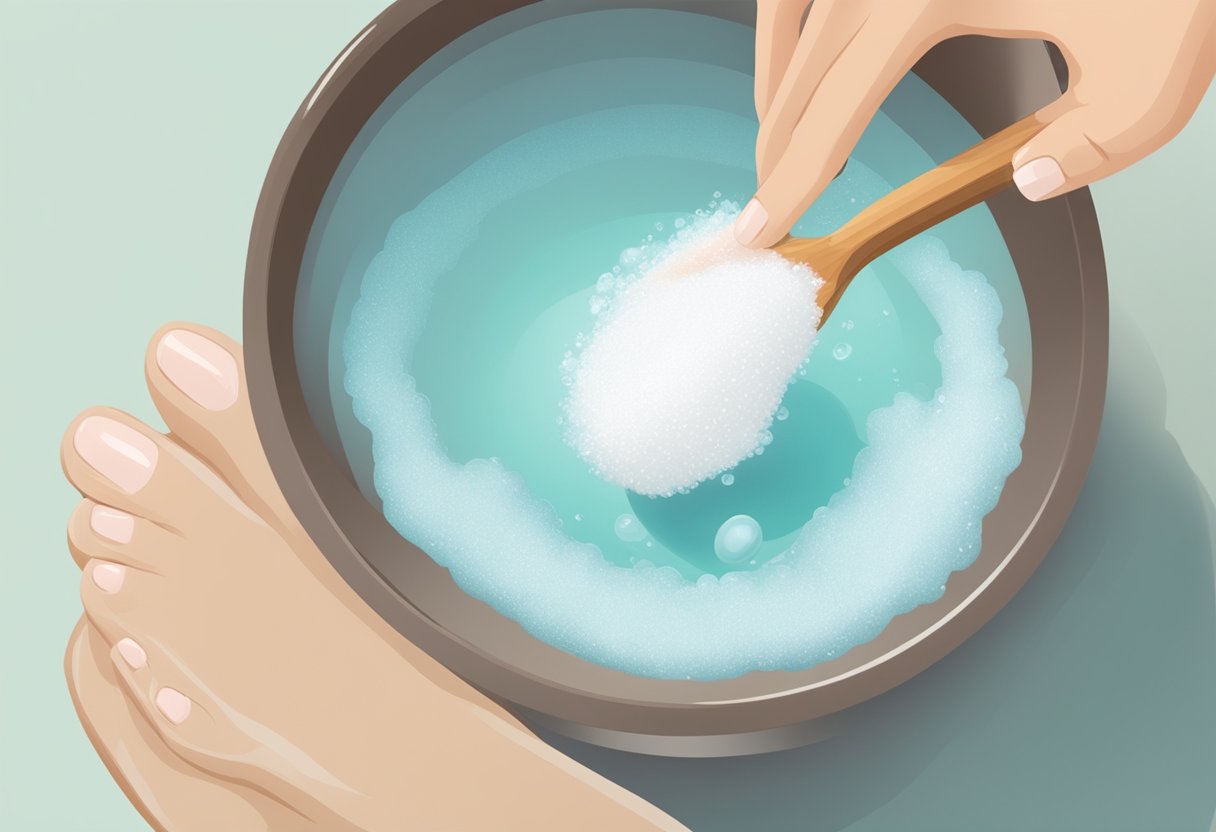Ingrown toenails can be a painful and uncomfortable experience, causing swelling, redness, and tenderness around the affected area. One popular home remedy for ingrown toenails is the use of Epsom salt. Epsom salt is a naturally occurring mineral compound that contains magnesium and sulfate, which can help to reduce inflammation and promote healing.

When it comes to using Epsom salt for ingrown toenails, the amount of salt to use can vary depending on the severity of the condition. In general, it is recommended to use about 3 tablespoons of Epsom salt per 2 quarts of warm water for a foot soak. The affected foot should be soaked in the solution for about 15-20 minutes, up to three times per day.
It is important to note that while Epsom salt can be an effective home remedy for ingrown toenails, it may not work for everyone. In some cases, ingrown toenails may require medical attention, such as antibiotics or surgical removal. If the condition does not improve or worsens, it is important to seek medical advice from a healthcare professional.
Understanding Ingrown Toenails

Ingrown toenails are a common condition that can cause discomfort and pain. They occur when the edge of the toenail grows into the surrounding skin, causing redness, swelling, and tenderness. This can lead to infection if left untreated.
There are several factors that can contribute to the development of ingrown toenails. These include wearing tight shoes or socks, cutting toenails too short or at an angle, and injury to the toe. People with certain health conditions, such as diabetes or peripheral arterial disease, may also be more prone to developing ingrown toenails.
Fortunately, there are several at-home treatments for ingrown toenails, including soaking the affected toe in Epsom salt. Epsom salt, also known as magnesium sulfate, is a natural mineral that can help reduce inflammation and relieve pain.
When using Epsom salt for an ingrown toenail, it is important to use the correct amount. A common recommendation is to mix 3 tablespoons of Epsom salt with 3 quarts of warm water and soak the affected toe for 15-20 minutes, up to three times a day. It is important to dry the foot thoroughly after soaking to prevent further infection.
In addition to Epsom salt soaks, other at-home treatments for ingrown toenails include gently lifting the edge of the nail, applying antibiotic ointment, and wearing open-toed shoes or sandals to reduce pressure on the affected toe. If the ingrown toenail is severe or does not improve with at-home treatments, it is important to seek medical attention from a healthcare professional.
Benefits of Epsom Salt for Ingrown Toenails

Epsom salt is a popular home remedy for treating ingrown toenails. It is a natural compound that contains magnesium and sulfate, which have been shown to have therapeutic benefits for the body. Here are some of the benefits of using Epsom salt for ingrown toenails:
Reduces inflammation and pain
Epsom salt has anti-inflammatory properties that can help reduce swelling and pain associated with ingrown toenails. Soaking your feet in warm water with Epsom salt can help relieve discomfort and promote healing.
Softens the skin
Soaking your feet in Epsom salt can help soften the skin around the toenail, making it easier to remove the ingrown nail. This can help prevent further damage to the nail and surrounding skin.
Helps prevent infection
Ingrown toenails can be prone to infection, especially if the skin is broken or damaged. Epsom salt has antibacterial properties that can help prevent infection and promote healing.
Promotes relaxation
Soaking your feet in warm water with Epsom salt can be a relaxing and soothing experience. It can help reduce stress and promote overall well-being.
How much Epsom salt to use
To make an Epsom salt foot soak, add 1/2 cup of Epsom salt to a basin or bowl of warm water. Soak your feet for 15-20 minutes, repeating the process 2-3 times a day until the ingrown toenail has healed.
It is important to note that while Epsom salt can be an effective home remedy for ingrown toenails, severe cases may require medical attention. If you experience severe pain, swelling, or signs of infection, it is important to seek medical advice.
Preparation of Epsom Salt Soak

Required Materials
To prepare an Epsom salt soak for an ingrown toenail, the following materials are required:
- Epsom salt
- Warm water
- A basin or foot tub
- Towel
Epsom salt is a mineral compound that contains magnesium and sulfate. It is known for its therapeutic properties and has been used for centuries to treat various ailments, including ingrown toenails.
Mixing Instructions
To prepare the Epsom salt soak, follow these instructions:
- Fill a basin or foot tub with warm water. The water should be warm, but not too hot, as it can cause burns or scalding.
- Add Epsom salt to the warm water. The recommended amount of Epsom salt is 3 tablespoons per gallon of water. Stir the water until the Epsom salt dissolves.
- Soak the affected foot in the Epsom salt solution for 15-20 minutes. The warm water and Epsom salt will help to soften the skin around the ingrown toenail and reduce inflammation.
- After soaking, dry the foot with a towel. Do not rub the affected area too hard as it can cause further irritation.
It is important to note that Epsom salt should not be used as a substitute for medical treatment. If the ingrown toenail is severe or infected, it is recommended to seek medical attention from a healthcare provider.
Application Process

Soaking Duration
When using Epsom salt to treat an ingrown toenail, it is important to soak the affected foot in warm water mixed with Epsom salt. The recommended soaking duration is 15-20 minutes per session. This allows the Epsom salt to soften the skin around the toenail and reduce inflammation, making it easier to pull the toenail away from the skin.
Frequency of Soaks
The frequency of Epsom salt soaks for an ingrown toenail depends on the severity of the condition. For mild cases, soaking the foot once a day is sufficient. For more severe cases, soaking the foot twice a day may be necessary. It is important to note that over-soaking the foot can cause the skin to become too soft and increase the risk of infection.
To ensure the best results, it is recommended to follow a consistent soaking routine until the ingrown toenail has healed. Additionally, it is important to properly trim the toenail straight across rather than in a curved shape to prevent future ingrown toenails.
Overall, using Epsom salt to treat an ingrown toenail can be an effective and affordable solution. By following the recommended soaking duration and frequency, individuals can experience relief from pain and inflammation caused by an ingrown toenail.
Post-Soak Care

After soaking the foot in Epsom salt for an ingrown toenail, it is important to follow up with proper post-soak care to ensure that the affected area heals properly. This section will cover two important aspects of post-soak care: drying the foot and applying antiseptic.
Drying the Foot
After soaking the foot in Epsom salt, it is important to dry the foot thoroughly. Moisture can lead to the growth of bacteria and fungi, which can cause further complications. Use a clean towel to gently pat the foot dry, paying extra attention to the affected area. Avoid rubbing the area vigorously as this can cause further irritation.
Applying Antiseptic
To prevent infection, it is important to apply antiseptic to the affected area after drying the foot. There are many different types of antiseptics available, including hydrogen peroxide, iodine, and antibiotic creams. Your healthcare provider may recommend a specific type of antiseptic based on your individual needs.
To apply antiseptic, first clean the affected area with a clean cotton ball or swab. Then, apply the antiseptic according to the manufacturer’s instructions. Be sure to cover the entire affected area, and avoid touching the area with your hands or any other objects to prevent contamination.
Following these two important steps can help promote proper healing and prevent complications after soaking the foot in Epsom salt for an ingrown toenail.
Frequently Asked Questions

What is the appropriate amount of Epsom salt to use for soaking an ingrown toenail?
The appropriate amount of Epsom salt to use for soaking an ingrown toenail is typically 2-3 tablespoons of Epsom salt per quart of warm water. This concentration is generally safe and effective for most people. However, it is important to note that the appropriate amount may vary depending on the individual’s sensitivity and the severity of the condition.
Can Epsom salt help in treating an ingrown toenail infection, and if so, how?
Yes, Epsom salt can help in treating an ingrown toenail infection. Epsom salt has anti-inflammatory and antibacterial properties that can help reduce swelling and prevent infection. Additionally, soaking the affected foot in warm water with Epsom salt can help soften the skin and make it easier to remove the ingrown toenail.
Is it beneficial to use scented or lavender Epsom salt for ingrown toenail relief?
While scented or lavender Epsom salt may provide a pleasant aroma, there is no evidence to suggest that they are more beneficial than plain Epsom salt for ingrown toenail relief. In fact, scented or lavender Epsom salt may contain additional ingredients that could potentially irritate the skin or worsen the condition.
What are the potential effects of Epsom salt on an ingrown toenail, and can it cause burning?
Epsom salt is generally safe and well-tolerated when used appropriately. However, in some cases, it may cause a mild burning or stinging sensation. This is typically due to the salt’s drying effect on the skin. To avoid this, it is important to use the appropriate concentration of Epsom salt and to limit soaking time to no more than 20-30 minutes.
How effective is Epsom salt in drawing out an ingrown toenail?
Epsom salt can be effective in drawing out an ingrown toenail, particularly when used in conjunction with other treatments such as proper nail trimming and antibiotic ointments. Soaking the affected foot in warm water with Epsom salt can help soften the skin and make it easier to remove the ingrown toenail. However, it is important to note that Epsom salt alone may not be sufficient to treat severe or persistent cases of ingrown toenails, and medical intervention may be necessary.

